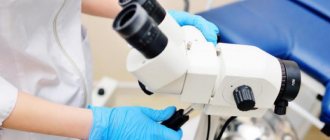- as mentioned above, STDs put you at risk;
- reduced immunity is fertile ground for the development of inflammatory diseases;
- unbalanced diet with a predominance of glucose and simple carbohydrates;
- alcohol abuse, smoking, drug use;
- wearing non-breathable (synthetic) underwear;
- regular trauma to the genital organs;
- neglect of personal hygiene rules;
- improper personal hygiene (use of alkaline compounds, frequent douching, etc.)
- early onset of sexual activity;
- frequent change of sexual partners;
- using tampons not according to the instructions (leaving the tampon in the vagina for a long time, inserting the tampon with dirty hands, etc.);
- hypothermia, including regular;
- recently undergone operations.
| Appointment with Ekaterina Nikolaevna Kozlova (initial / repeated up to 2 months / repeated from 2 months) | 5 000,00 / 4 000,00 / 5 000,00 | View all services |
How do pathological microorganisms enter our body?
Some opportunistic microorganisms are always present in our body, but the immune system does not allow them to manifest themselves. These are, for example, chlamydia, trichomonas, etc. But as soon as the body malfunctions, their negative influence begins. As for the ways in which harmful microbes enter, there are several:
- during sexual intercourse;
- microbes independently penetrate the tissues of the genital organs (for example, due to improper hygiene);
- harmful microorganisms enter the software, moving throughout the body with blood or lymph.
Advantages
Smart medicine for smart people
Safe, effective and natural rejuvenation
The best technologies for communicating with patients
We don't just take care of your beauty - we recharge you!
Symptoms of the disease
The main thing to pay attention to is any discomfort in the intimate area. In itself, this is already a reason to visit the gynecological office. Among the signs of the inflammatory process in the genital area are:
- swelling of the mucous membrane;
- itching, discoloration of the external genitalia;
- pain during sex;
- aching, pressing pain in the lower third of the abdomen;
- pain in the genital area;
- discomfort in the lower back;
- atypical vaginal discharge: changes in smell, texture, color;
- bleeding outside of menstruation;
- impurities of pus in the discharge;
- menstrual irregularities;
- difficulty urinating, pain during urination;
- increased body temperature, fever;
- increased fatigue;
- upset stomach, nausea, vomiting.
The presence of several symptoms means that you definitely need to see a gynecologist. Take responsibility for your health and the health of your partner!
The most common female diseases: symptoms and treatment
Women's health is an important and sensitive topic. Any disease causes discomfort, disrupts the quality of life, and can lead to serious consequences. The situation is complicated by the fact that discussing intimate problems with someone is not always possible. Even when visiting a doctor, women often feel awkward describing their symptoms.
Meanwhile, there is no need to be shy about issues related to the health of the reproductive organs. Most diseases that can cause infertility, the growth of malignant cells and other serious pathologies are easily treated in the early stages. At the first signs of illness, you should consult a doctor. The specialist will make a diagnosis and prescribe appropriate treatment.
Causes of development of female diseases
There are external and internal provoking factors.
External causes of disease development:
- unfavorable ecological environment;
- neuroses, psychological stress, chronic stress and frequent depression;
- promiscuity;
- mechanical injuries of the external and internal genital organs;
- viral and bacterial infections, including STIs;
- early onset of sexual activity;
- incorrect choice of underwear;
- insufficient hygiene of intimate areas;
- local allergic reaction to fabrics, cosmetics;
- frequent and incorrect use of medications, especially oral contraceptives and antibiotics.
Internal provoking factors:
- inflammatory processes in the body that are a source of infection: chronic tonsillitis, sinusitis, pyelonephritis, etc.;
- hormonal imbalance due to gynecological, endocrine diseases;
- anomalies of the anatomical structure of internal organs;
- frequent miscarriages, abortions;
- the presence of systemic diseases (for example, diabetes).
Types of female diseases
According to the etiology of the disease there are:
- Inflammatory. Pathology is caused by the activity of microorganisms: viruses, bacteria, fungi. Diseases such as endometritis, mastitis, colpitis, and thrush are manifested by inflammation.
- Hormonal. Pathologies develop against the background of a hormone imbalance caused by disruption of the glands. This group of diseases is characterized by severe and multiple symptoms. Hormonal changes cause uterine fibroids, endometriosis, menstrual irregularities, and provoke the development of conditional pathologies such as multifollicular ovaries.
- Hyperplastic. The cause of the disease is the growth of a tumor. The tumor can be benign or oncological in nature. Hyperplastic diseases include cervical erosion, cysts, breast cancer, etc.
Let's look at the most common female diseases.
Inflammation of the uterine appendages
The disease develops when pathogens (gonococcus, streptococcus) or conditionally pathogenic microbes enter the body against the background of decreased immunity. Inflammation of the uterine appendages is often diagnosed after hypothermia, installation of an intrauterine device, or artificial termination of pregnancy.
Main symptoms:
- pain in the lower back and lower abdomen from the inflamed organ, which can radiate to the sacrum or anus;
- copious discharge with an unusual odor;
- weakness due to general intoxication;
- elevated body temperature.
Inflammation can spread to the ovaries and fallopian tubes, become chronic, which is more difficult to treat, and affect one or both uterine appendages. If left untreated, complications arise. According to medical statistics, about 20% of women suffering from infertility previously had inflammation of the uterine appendages and were not treated in a timely manner. The pathology also increases the risk of ectopic pregnancy. In advanced cases, purulent processes develop in the internal genital organs.
For diagnosis, an examination by a gynecologist is sufficient.
Uterine fibroids
Myoma is formed from muscle cells and is a benign tumor. The neoplasm does not degenerate, but increases in size. The growth of uterine fibroids causes discomfort and creates the risk of bleeding. During menopause, due to a decrease in the level of female sex hormones, the formation may decrease in size.
Causes of uterine fibroids:
- hormonal imbalance with an increase in the level of estrogen and progesterone in the blood;
- frequent abortions, curettage of the uterine cavity;
- irregular sex life;
- passive lifestyle.
Myoma has no characteristic symptoms. A woman learns about the presence of a neoplasm during a routine examination by a gynecologist or an ultrasound scan. In rare cases, bleeding that is not associated with menstruation is observed. A large tumor makes it difficult to urinate.
Endometriosis
The endometrium is the inner layer of cells lining the uterus. The peculiarity of the tissue is its ability to respond to changes in hormonal levels during the cycle. During the period of ovulation, when the uterus is preparing for fertilization, the endometrium thickens, grows, and a branched network of blood vessels is formed. If conception does not occur, the cells gradually exfoliate and menstruation begins.
Endometriosis is a pathology that is manifested by abnormal growth of the endometrium outside the uterine cavity. The disease has many causes: hormonal disorders, decreased protective function of the body, hereditary predisposition, etc. Endometriosis of the uterine appendages is accompanied by an enlargement of these organs.
There are no characteristic symptoms of pathology. Tissue proliferation does not manifest itself in any way in the initial stages. As the disease progresses, the following signs appear:
- heavy and painful menstruation;
- cycle disorders;
- weakness, general malaise;
- periodic lower back pain;
- spontaneous bleeding not associated with the menstrual cycle.
Mild forms of endometriosis are treated with conservative methods. In severe cases, laparoscopy is performed.
Cervical erosion
Disorders of the cervical mucosa are often diagnosed in women of reproductive age. The disease itself is not life-threatening, but it must be treated to prevent complications. Cervical erosion develops against the background of hormonal disorders, decreased immunity, inflammation, and endocrine diseases. To diagnose and exclude malignant processes, colposcopy is indicated.
Symptoms of pathology:
- pain during sexual intercourse;
- itching and discharge when infection occurs.
Signs of the disease rarely appear. Usually a woman learns about erosion at an appointment with a gynecologist. There are many modern treatment methods that completely eliminate the pathology without damaging or injuring the cervix.
Colpitis
An inflammatory disease localized in the vagina. Colpitis can be caused by any infectious agent: bacteria, virus, fungus. The disease is more often diagnosed in young women who are sexually active.
Symptoms of colpitis:
- pain in the lower abdomen;
- copious discharge that causes itching and burning of the external genitalia;
- rash on the skin of the perineum;
- dysuria (painful urination, frequent urge);
- swelling of the external genitalia.
The disease in its acute form has pronounced symptoms, the quality of life decreases, and the woman feels constant discomfort.
Chronic colpitis is less pronounced. The only symptoms that may be present are discharge and itching. Periods of exacerbation are followed by remissions.
Thrush
An inflammatory disease caused by the growth of the fungus Candida. These microorganisms are present in the microflora of every person, but do not manifest themselves in any way. In order for the fungus to begin to actively grow and cause disease, provoking factors are needed. The aggressiveness of the pathogen can be provoked by long-term use of antibiotics, decreased local immunity, poor hygiene of intimate areas, hormonal imbalances and other reasons.
According to statistics, about 75% of women have experienced symptoms of candidiasis at least once in their lives:
- leucorrhoea of a cheesy nature with a sour odor;
- burning sensation in the perineum after sexual intercourse;
- soreness, itching in the vagina.
Thrush can occur with acute manifestations or be chronic.
Polycystic ovary syndrome (PCOS) and multifollicular ovaries
The disease is more often diagnosed in women aged 25–30 years. The prevalence of pathology is 2.5–8%.
The phenomenon of multifollicular ovaries itself is not a pathology. However, the process of follicle maturation and ovulation is disrupted. Gradually, the ovary becomes covered with multiple formations (non-ovulated follicles) - polycystic disease is formed. Among the causes of the disease are a genetic predisposition to increased levels of androgens and obesity.
Symptoms of PCOS:
- painful menstruation;
- the appearance of acne on the face;
- fluctuations in blood pressure both up and down;
- depressed state, depression;
- alopecia of certain areas or, conversely, excess hair growth (for example, mustache);
- skin pigmentation.
The most characteristic symptom of polycystic disease is irregular menstruation. The duration of the cycle can be several months.
Menstrual irregularities
Failure to menstruate is not a disease - it is a symptom of other pathologies. Normally, menstruation lasts from 3 to 8 days and repeats every 3-5 weeks. A cycle that is too long or too short, heavy or scanty discharge should be considered a symptom of the disease. A doctor's consultation is required. The absence of menstruation during childbearing age is a serious pathology.
The causes of menstrual irregularities are various:
- thyroid diseases, diabetes mellitus;
- hormonal disorders due to dysfunction of the ovaries and pituitary gland;
- chronic fatigue, stress;
- gynecological diseases with acute or chronic course;
- unfavorable ecological environment;
- irregular and/or unhealthy diet;
- malignant neoplasms.
To find and eliminate the cause of menstrual irregularities, a woman is prescribed a comprehensive laboratory and instrumental examination.
Mastitis
The disease develops in the mammary gland. Mastitis is an inflammation of the ducts or functional tissues of the breast. More often, the pathology is diagnosed in nursing women. The vast majority of cases occur in first-time mothers.
The main reason for the development of mastitis is stagnation of breast milk. Liquid is an ideal breeding ground for bacteria. The development of infection causes characteristic symptoms:
- feeling of fullness, tightness, pain in the mammary gland;
- redness and swelling of the skin on the side of inflammation;
- increase in body temperature.
Lack of treatment threatens the appearance of an abscess and sepsis. Timely consultation with a doctor allows you to quickly and completely get rid of mastitis.
Mammary cancer
Cancer is a malignant tumor. In different regions of the world, the prevalence of the disease ranges from 10 to 30%. Breast cancer affects women of all ages, including teenage girls. After 65 years, the risk of developing a malignant tumor increases several times compared to the group of patients under 30 years of age.
The cause of breast cancer can be genetic predisposition, radiation, refusal of breastfeeding after childbirth, lack of pregnancies or too frequent abortions, bad habits, poor environment, endocrine diseases, hormonal imbalance.
Malignant formation in the early stages has no symptoms. You can detect cancer yourself by palpating the breast - small nodules and lumps are detected. Women over 40 years old undergo mammography, which is also an effective method of early diagnosis.
Symptoms of breast cancer are nonspecific:
- frequent mastopathy and breast tenderness;
- menstrual irregularities;
- enlarged axillary lymph nodes;
- swelling of the breast.
At later stages, visible changes appear on the skin of the diseased mammary gland. A so-called lemon peel is formed. The skin changes color and becomes wrinkled. The progression of the disease causes retraction of the nipple, spread of the tumor into the armpits, the appearance of metastases, and ulcerations on the surface of the mammary gland.
Treatment of female diseases
When the first symptoms appear, you should consult a gynecologist. The specialist conducts an examination and takes a swab from the vagina. If necessary, the patient is prescribed additional tests, ultrasound, and other research methods.
Treatment is carried out comprehensively. Therapy is aimed not only at eliminating symptoms, but also at combating concomitant diseases.
Depending on the diagnosis, the patient is prescribed:
- Non-steroidal anti-inflammatory drugs. The drugs help eliminate inflammation and alleviate the patient’s condition with urinary tract infection. Medicines also have an analgesic effect for menstrual irregularities.
- Antibiotics, antiviral drugs, antiseptics, antimycotics. Medicines with broad or targeted action eliminate the causative agent of the disease. The type and dosage of medications is selected by the doctor after diagnosis.
- Hormonal agents. An effective remedy for restoring the menstrual cycle, treating tumors, inflammation, and concomitant diseases. Hormones are prescribed for recovery after surgical treatment, to prevent unwanted pregnancies, normalize hormonal levels and treat infertility.
- General strengthening drugs. After treatment, a woman needs to take care of her immunity. A course of vitamins is an adjuvant to the main therapy. Additionally, your doctor may prescribe iron supplements, for example, after heavy menstruation or bleeding.
Physiotherapy is actively used in the treatment of gynecological diseases. The procedures are carried out in courses of several days. In cases of severe chronic disease, surgical intervention is indicated. Treatment is carried out in a hospital using modern gentle methods. For example, after laparoscopy, the patient can go home 2–4 days after the operation; there are practically no scars left on the skin.
An important factor in maintaining women's health is regular medical examinations and preventive examinations by a gynecologist.
Diagnosis and treatment of female diseases in Moscow
MedEx Personal Medicine Clinic provides the opportunity to consult a gynecologist and undergo the necessary examinations in one place and in the shortest possible time. Don’t put off visiting a doctor—women’s diseases are best treated at an early stage.
Types of inflammatory diseases of the female genital organs
From the point of view of origin, inflammatory pathology can be specific and nonspecific . The first category of diseases is caused by infections transmitted during sexual intercourse. These are herpes, chlamydia, gonorrhea, HIV, etc. The second type of inflammation occurs due to a woman’s own flora, which is activated due to decreased immunity and other disruptions in the functioning of the body.
From the point of view of the intensity (nature) of the inflammatory process, it can be acute, subacute, chronic and aggravated . It is very difficult not to notice the acute course of inflammation - the patient is plagued by pain, itching and other characteristic symptoms. The severity of the subacute condition is slightly less, but it also brings significant discomfort to life. Inflammation that lasts more than one month is considered chronic. This does not mean that during the entire 30 days the patient endlessly experiences pain and encounters other unpleasant symptoms. The genitals will hurt, itch, and swell only during periods of exacerbation.
From the point of view of location, inflammation of the PO is conventionally divided into lesions:
- upper genitalia (endometritis, myometritis, salpingitis, etc.)
- lower genitalia (vaginitis, vulvitis, cervicitis, etc.)
Inflammatory diseases of the vagina and cervical canal
Inflammation of the vagina is much more common than that of the external genitalia. Moreover, they can be provoked by a variety of microorganisms, which determines the differences in their course and treatment features.
Bacterial vaginosis
Bacterial vaginosis, or, as it is also called, vaginal dysbiosis, cannot be called a full-fledged disease, but its presence creates clear preconditions for the development of more severe infectious processes. With it, there is a decrease in the number of lactobacilli and an increase in the number of opportunistic microorganisms. This leads to an increase in pH to 7.0-7.5, which destroys the natural defense mechanism against infections.
Bacterial vaginosis is found in 21-33% of women.
With bacterial vaginosis the following is observed:
- an increase in the volume of discharge, which has a uniform consistency, but can acquire the smell of rotten fish and stick to the walls of the vagina;
- itching and burning in the vagina;
- discomfort during sexual intercourse.
A characteristic sign of the disease is the detection of key cells in smear microscopy, a decrease in the number or complete absence of Dederlein rods and the detection of leukocytes.
Treatment of bacterial vaginosis consists of using antimicrobial agents, vitamins, and then restoring normal vaginal microflora with the help of special probiotics in the form of suppositories. There is no need to abstain from sexual intercourse during treatment, but you should use a condom when contacting a new partner to avoid contracting other infections.
Nonspecific vaginitis or colpitis
Nonspecific vaginitis is called inflammation of the vaginal mucosa, provoked by invasion of microorganisms or the action of chemical, mechanical or thermal factors. Most often it is caused by representatives of opportunistic microflora and may be a consequence of an increase in their virulence, i.e., the ability to cause pathological processes, against the background of decreased immunity.
Colpitis is characterized by the appearance of:
- itching and burning in the vagina;
- purulent or serous-purulent discharge;
- discomfort during sexual intercourse;
- swelling and redness of the vaginal mucosa;
- formation of pinpoint hemorrhages on the mucous membrane in places where it is touched (in severe cases, the formation of erosions and ulcers is possible).
Colpitis is often combined with vulvitis, urethritis, and endocervicitis.
Nonspecific vaginitis can become chronic. In such situations, patients also experience itching and burning in the vagina, but the intensity of the sensations is much lower than with acute colpitis. As a rule, the reason for a visit to the gynecologist in such cases is copious serous-purulent discharge.
Treatment of colpitis is always comprehensive and at the same time aimed at destroying the causative agents of the disease, eliminating concomitant diseases, and strengthening the immune system. Therefore, patients are advised to use antibacterial and antimicrobial drugs in the form of suppositories, sometimes hormonal agents, as well as probiotics to restore normal flora and acidity.
Vaginal candidiasis
Vaginal candidiasis is one of the most common infectious diseases of the genital organs. Its causative agent is yeast-like fungi of the genus Candida, which are single-celled aerobic microorganisms. Popularly, this disease is often called thrush.
Vaginal candidiasis is not considered a sexually transmitted disease (STD), since different strains of Candida can live in the vagina constantly, but become active only when favorable conditions are created for them (a slightly acidic environment, decreased immunity). But the development of candidiasis is very often a marker of the development of STDs. Therefore, if it is detected, it is recommended to get tested for STDs.
Signs of thrush are:
- severe itching and burning in the vagina, which tends to intensify after water procedures, sexual intercourse and at night;
- cheesy discharge from the genital tract;
- swelling and redness of the mucous membranes of the vagina;
- the presence of a characteristic white, thick coating on the walls of the vagina.
In acute vaginal candidiasis, involvement of the vulvar mucosa in the inflammatory process is observed. This may be accompanied by the formation of vesicles, which rupture with the formation of erosions in their place.
Very often, due to self-medication, candidiasis becomes chronic. In such situations, the disease regularly recurs and is difficult to treat. Therapy for thrush consists of prescribing antifungal drugs, as well as eliminating factors contributing to its development. Therefore, women are advised to stop taking COCs, corticosteroids, cytostatics, and antibiotics, if possible. To eliminate acute vaginal candidiasis, it is enough to use local remedies, but for a chronic inflammatory process, systemic medications will be required. In any case, the choice of specific antifungal agents should be based on the results of bacterial culture with determination of the sensitivity of the detected fungi to various active substances with antifungal activity.
Trichomonas vaginitis
Trichomonas vaginitis is also a common problem of our time. It is already classified as an STD, since the causative agent of the disease, Trichomonas vaginalis, is an aggressive pathogenic microorganism and is normally absent from the vaginal microflora. They affect sperm motility, therefore, in the presence of Trichomonas vaginitis, the possibility of pregnancy is extremely low.
60-70% of women have encountered trichomonas vaginitis at least once in their lives.
Very often, trichomonas vaginitis is combined with other STDs, including gonorrhea, viral diseases, chlamydia, etc. In most cases, the infection does not extend beyond the vagina, although it can affect the cervical canal, the uterus, and the organs of the urinary system.
Trichomonas can serve as a container for other pathogenic microorganisms, for example, gonococci, ureaplasma, chlamydia, etc. Therefore, after their destruction, the development of gonorrhea, chlamydia, and ureplasmosis, respectively, is possible.
Typical symptoms of the disease are:
- itching and burning in the vagina;
- a large amount of foamy discharge;
- increased urge to urinate and pain (if Trichomonas affects the urethra).
The incubation period can range from 3 to 30 days.
Treatment of trichomonas infection is prescribed to all sexual partners. Be sure to avoid sexual intercourse during the procedure. The essence of therapy is the prescription of specialized antimicrobial drugs, as well as the treatment of all other detected infections.
Endocervicitis
Endocervicitis is an inflammatory process in the cervical canal that develops against the background of injury to its mucous membrane during manipulations on the uterus or during childbirth. It often accompanies other inflammatory processes of a gynecological nature, in particular colpitis, adnexitis, endometritis, and the cervical canal mucosa itself is very sensitive to gonococci and chlamydia. Also, endocervicitis often occurs against the background of the development of non-inflammatory diseases, including ectropion of the cervix, ectopia and others.
It is characterized by the appearance of mucopurulent discharge, which is sometimes accompanied by nagging pain in the lower abdomen. During the examination, the gynecologist may detect swelling and redness of the mucous membrane of the vaginal part of the cervix, erosion. If a woman delays seeing a doctor and starting treatment, inflammation of the cervical canal can lead to the development of cervicitis, which will also involve the muscular layer of the cervix, which will provoke the formation of so-called nabothian cysts.
If the cause of inflammation is gonococci, they speak of the presence of gonorrhea, but if it is provoked by chlamydia, it is urogenital chlamydia. From the cervical canal, microorganisms can penetrate the uterus and fallopian tubes, causing their inflammation. Gonorrhea is characterized by purulent discharge, the consistency of which resembles cream. Chlamydia is accompanied by serous-purulent discharge.
Treatment of endocervicitis consists of prescribing antibiotics taken orally. The use of local remedies in such situations is not indicated due to the high risk of infection spreading to the upper genital organs.
Consequences of inflammatory diseases
- If the inflammatory disease is not treated in time, it will become chronic and will occupy a woman’s thoughts instead of pleasant things. The disease will recur, which will make it impossible to have a harmonious personal life, regular exercise, etc.;
- an inflammatory disease can trigger the formation of malignant cells and lead to oncology;
- advanced inflammation may require surgical intervention;
- inflammation can spread to neighboring organs;
- If not treated in time, the disease leads to infertility.
II. Inflammatory processes of nonspecific etiology of the upper genital organs.
Endometritis is an inflammation of the uterine mucosa. Acute endometritis often occurs after abortion, childbirth, or diagnostic uterine curettage. Chronic endometritis, as a rule, occurs as a result of untreated acute postpartum or post-abortion endometritis; its development is often facilitated by repeated intrauterine interventions due to uterine bleeding.
Salpingo-oophoritis - inflammation of the uterine appendages - is one of the most common diseases of the reproductive system. It usually occurs via an ascending route when infection spreads from the vagina, uterine cavity, most often in connection with complicated childbirth and abortion, as well as descending – from adjacent organs (appendix, rectum and sigmoid colon) or hematogenously. The course of salpingoophoritis can be acute, subacute and chronic. The severity of the inflammatory process of the fallopian tubes and ovaries depends on the virulence of the pathogen, on the extent of the spread of the process throughout the peritoneum and on the reactivity of the body. Saccular formations of the uterine appendages—pyosalpinx, ovarian abscess, and tubo-ovarian formations—can be considered complications of inflammatory processes. Pelvioperitonitis is an inflammation of the pelvic peritoneum.
Pelvioperitonitis is a secondary inflammatory process that develops as a complication of inflammation of the uterus and appendages, pyosalpinx or pyovar. Depending on the nature of the exudate, serous-fibrinous and purulent pelvioperitonitis are distinguished. The serous-fibrous form is characterized by the development of adhesions and relatively rapid delineation of inflammation. With purulent pelvioperitonitis, pus accumulates in the retrouterine cavity.
A special form of pelviperionitis is an abscess of the rectal-uterine pouch of the peritoneum, which can occur due to rupture of the pyosalpinx, pyovar, perforation of the uterus during out-of-hospital abortion, suppuration of the hematoma during a disturbed tubal pregnancy.
Parametritis is inflammation of the periuterine tissue. Predisposing factors to the occurrence of parametritis (outside of pregnancy) may be dilation of the cervical canal, diagnostic curettage, surgery on the cervix, insertion of an IUD with trauma to the walls of the uterus, removal of an intraligamentous tumor. It also occurs after pathological childbirth.
Treatment of inflammatory diseases of the female genital organs
The structure of treatment depends on the type of disease, its neglect and the general health of the patient (presence of chronic diseases, age, reproductive plans, etc.). A treatment plan can only be drawn up after a detailed diagnosis, including:
- smear, cytology;
- Ultrasound examination;
- colposcopy;
- if necessary, blood tests, urine tests, CT scans, MRIs, etc.
For the treatment of inflammatory diseases, douching, washing, antiviral and antibacterial drugs, drugs to strengthen the immune system, ointments, suppositories, etc. are prescribed.
Sometimes treatment requires surgery.
MIGUNOVA ANASTASIA ANDREEVNA
Cosmetologist
Initial consultation: RUB 4,500
Make an appointment with a doctor Instagram
VYATKINA IRINA SERGEEVNA
Gynecologist-endocrinologist
Initial consultation: RUB 8,500
Make an appointment with a doctor Instagram
KALININA EKATERINA ALEXANDROVNA
Cosmetologist
Initial consultation: RUB 4,500
Make an appointment with a doctor Instagram
KOZLOVA EKATERINA NIKOLAEVNA
Gynecologist-endocrinologist, oncologist
Initial consultation: RUB 5,000
Make an appointment with a doctor Instagram
Endometritis
This is an inflammation of the lining of the uterus.
Causes:
most often associated with previously performed invasive interventions: separate therapeutic and diagnostic curettage of the uterine cavity and cervical canal, abortion, as well as as a result of severe childbirth, previous infections.
According to the nature of the flow, they are distinguished:
acute or chronic.
In acute endometritis it is possible:
- temperature increase;
- chills;
- asthenia;
- nagging pain in the lower abdomen;
- copious discharge from the genital tract, possibly bloody.
If such symptoms appear, it is imperative to seek help from a doctor!
In a chronic course, a woman may experience:
- intermenstrual bleeding;
- hypomenstrual syndrome (scanty menstruation);
- inability to become pregnant, or with episodes of miscarriage.
Such complaints are not uncommon among patients in our department and require a personalized approach to each patient with the prescription of appropriate therapy.
Diagnosis of endometritis:
- collection of anamnesis, patient complaints, examination on a gynecological chair “in the mirrors”;
- smears for microbiocenosis, PCR for infections;
- blood tests;
- ultrasound examination of the pelvic organs;
- aspiration/pipe/vacuum aspiration biopsy of the endometrium followed by histological examination;
- hysteroresectoscopy/separate therapeutic and diagnostic curettage of the uterine cavity and cervical canal, followed by histological examination.
Treatment:
- antibacterial therapy;
- anti-inflammatory therapy;
- detoxification therapy;
- immunomodulatory therapy;
- surgical treatment if necessary (for example, the presence of intrauterine synechiae);
- An important stage is rehabilitation: including hormonal and physiotherapeutic therapy.
Prevention
- Regular, sufficient and proper personal hygiene. Wearing panties made of breathable material, refusing to use panty liners, or wearing thongs. Timely replacement of tampons during menstruation. Washing with suitable products.
- No self-medication! Douching, introducing medications or traditional medicine into the vagina without the consent of a gynecologist is DANGEROUS!
- The same goes for taking oral medications. Don't self-medicate!
- Use contraception that is selected for you.
- Avoid promiscuity - take responsibility for your health.
- Be sure to use condoms with a new sexual partner. Oral contraceptives prevent unwanted pregnancy, but do not protect against infections.
- Monitor your overall health: visit an endocrinologist, get annual check-ups. And, of course, once every six months/year come for a preventive appointment with a gynecologist!
- Eat fully and balanced. Try not to eat fatty, spicy, salty, fried, alcohol.
- Monitor your work and rest schedule. Sleep at least 7 hours a day. Try to keep the same eating and sleeping schedule every day.
Reviews
Tatiana
I am happy to be among your guests at the clinic, I enjoy our communication, I am grateful for your super professionalism, for giving beauty and a sense of confidence in your professional actions, protection from “age-related changes”









